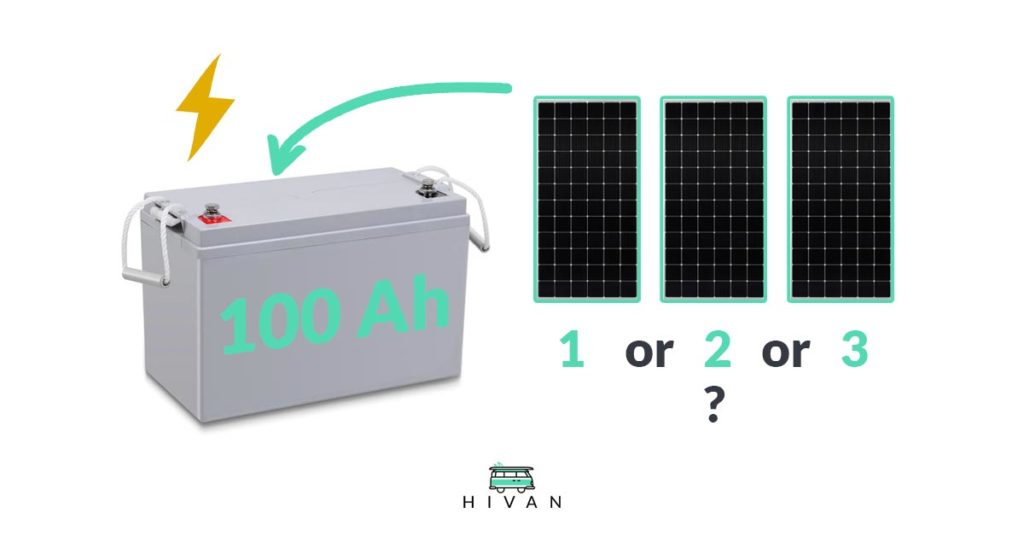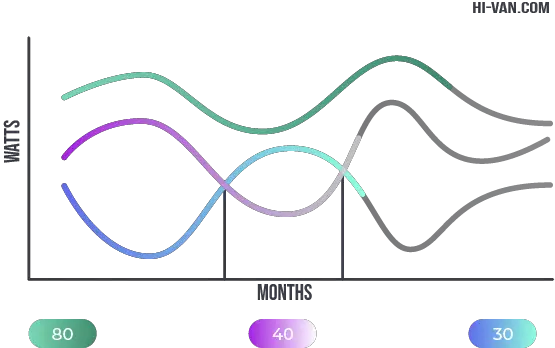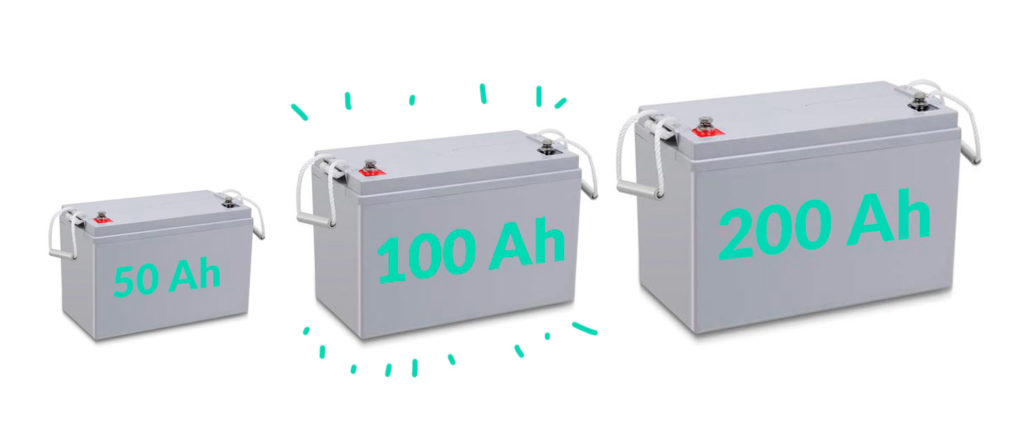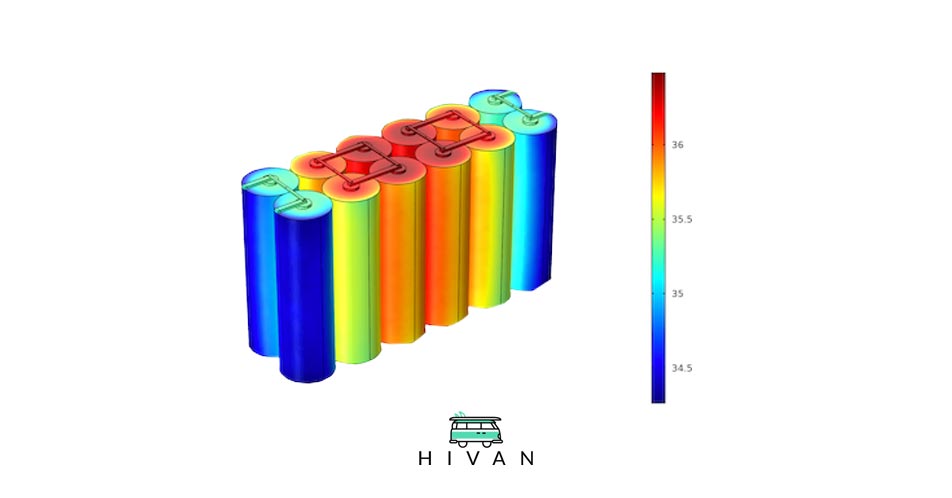Hi-van is supported by its audience. When you purchase using our links, we may earn an affiliate commission (no added cost to you). Learn more
If you are a newbie to RV camping, it can be confusing and cumbersome to think of the type of setup you would require for this newfound lifestyle choice. I totally understand your current situation as I was at the same place as you a couple of years before. That’s why I made a van build resource page that will dramatically help you.
With that said, a solar system is an affordable smart solution for van-lifers, easy to maintain, set up, and operate. It is flexible enough to cater to a wide range of camping solutions and lifestyle choices, from entirely off-grid to a partial solar setup usage.
With such a wide array of solutions, it can be pretty daunting to choose the right panel and battery combination to cater to your power needs.
To know how many solar panels we need to charge a 100Ah battery, we need to assume we have 5 hours of sunlight in perfect condition. We can then do the following calculations to know our needs in solar panels:
100Ah / 5 hours = 20Amp
20Amp x 12 volts = 240 watts
We need 240 watts of solar panels to charge our 100Ah battery. You can have the following sizes of solar panels wired in series:
- 2 x 120w panels
- 3 x 100w panels
- 5 x 50w panels
Solar panel modules come in different types, some being solid or flexible and using different materials. It can sometimes be challenging to make a choice. The Solar Calculator by Renogy is a great tool; don’t hesitate to try it to understand your consumption better. It will help you define your needs, and therefore you’ll be able to choose better which solar system you should go for.
The same situation applies when you need to choose your battery. Your final choice will be determined by the amount of power you need and the average amount of sun available in your area.

l recommend getting a solar controller rated for the total wattage and amperage you will have running through your system. The solar controller can make or break the solar installation.
You can also calculate the number of panels you’ll need with the following formula:
- Battery Ah x Battery Voltage = Watt Hours
- Watt-Hours / Hours Of Sunlight You Get A Day = Total Watts Of Solar Panels You Require – you can choose between having one solar of this wattage or several smaller panels.
- Total Watts x 10 to 20% = Indeed, it is always better to assume a loss of sunlight during the day that could be due to clouds or shadow from a particular object.
- I recommend you overcompensate your system requirements by 10 to 20 %
We can also use the battery size to find the right
Using 100 Ah 12 volt battery as an example,
- 100Ah x 12 = 1200 Watt-hours (total wattage)
- 1200/6 hours of sunlight in a day = 200 Watts(watts produced per hour)
- 200 Watts x 20% = 240 Watts(20% compensation added)
- I can get two 120 Watts panels or 3 *100 Watts panels; this
solar panel array can suit this particular battery size.
Estimate how many solar panels you need

solar panel with a high wattage and efficiency won’t be useful if matched with a small capacity battery.
Firstly, it is vital to calculate the total power you’ll need and buy the battery based on this estimated amount. You can then choose your solar panels to have sufficient power production that will allow you to fully charge your battery capacity in a respectable amount of time.
Most RV owners get confused when searching for the right
We will try to answer this pertinent question by going into more in-depth explanations regarding solar panels and batteries available on the market today.
Solar System Sizing

There are three main points you want to keep in mind when building a solar installation:
- Budget constraints: try to build your install within the set budget.
- Space constraints: build your system within the available space, especially regarding your solar panels.
- Energy offset: Build that caters to your energy usage.
You should also consider other factors and constraints that may impact how you size a solar system:
- Local levels of sun exposure
- Will you be able to tilt the
solar panel and improve its overall production by up to 30%? - Are you planning to expand your installation in the future?
- Solar panel efficiency ratings
- Wear of the system and also its cost of maintenance.
You should be able now to have a rough idea of the size of the system. You can now move on to designing the whole setup according to your system requirements, also taking into cognizance the following factors:
Measure your power usage

It consists of taking the wattage of your devices and adding them all together, considering their approximate daily usage. This exercise will provide you a baseline about the amount of power you’ll need daily.
The Solar Calculator by Renogy is a great tool; don’t hesitate to try it to understand your consumption better.
You can find your different devices’ power consumption (Watts) in their manual or directly on their label (usually stuck on the back).
Batteries are rated in Amps. We recommend Lithium-Ion batteries as the best for any Recreational Vehicle, but you can research this more if you want.
A 100ah battery is calculated as providing 1 amp for 100 hours, 2 amps for 50 hours, 3 amps for 33 hours, etc.
But in the perfect world, this equation of 100 amps for 1 hour has its limitations.
Solar Panel Ratings to keep in mind
Wattage: The amount of power (how much electricity) the
Cell efficiency: That’s the amount of energy a cell is capable of producing from the sunlight. The higher this number is, the less surface you’ll need for the same production capacity.
Temperature coefficient: Solar panels don’t like heat, and their ability to produce energy will decrease as the temperature gets higher. The current average hovers around 0.40% decrease for every 1 degree over 25° celsius (77°F).
Therefore, you will have to keep in mind those different ratings while choosing your solar panels.
Related Articles: How do solar panels work on a van? (an in-depth look) How many solar panels do I need for my van?
Why choose a 100Ah Battery?

What makes this type of battery the perfect choice when compared with other rated batteries? The 100 amp battery provides an RV owner with a reasonably priced but high capacity unit that can charge smartphones, wifi routers, cameras, laptops, and many more.
Its size is generally not too big and will easily fit into almost any RVs.
What does 100ah mean?
It can be confusing if you are new to solar systems.
100ah means that a battery can deliver 1 amp of current at the rated voltage for 100 hours.
“AH” stands for “amp hours”, Thus, you get this:
2 amps for 50 hours using a 12 V system.
4 amps for 25 hours using a 12V system.
100 amps for 1 hour when using a 12V system.
To get the wattage for this type of battery,
A 100ah battery will provide 1 amp X 12 Volts = 12 Watts for 100 hours.
100 amps X 12V = 1200 Watts for one hour.
 The advantages of a 100ah battery
The advantages of a 100ah battery
The quality of any distinct 100ah deep cycle battery is determined by the quality and strength of the materials used and the battery’s interior structure design.
The best deep cycle batteries are one that provides consistent, reliable, and safe power for as many charging cycles as possible over its prescribed lifetime.
The following 100ah 12V batteries are reliable and have a reasonable or fair amount of cycles available. They also provide consistent levels of storage power.
Related Articles: A guide to the best batteries for on the go solar
Different 100ah Batterie Types
- Dimensions: 12.17 inches x 6.61 inches x 9.16 inches. Weight: 63.93 Lbs
- SLA/AGM maintenance free, spill proof battery
Built tough with a leak-proof design, this maintenance-free battery was designed with solar energy storage applications in mind and provides optimum performance even at freezing temperatures.
In comparison with flooded lead-acid batteries, sealed lead-acid batteries are maintenance-free and are also spill-proof. They are more expensive than flooded lead-acid batteries but also have a much longer cycle life expectancy.
Sealed lead-acid batteries are of two types: absorbent glass matt (AGM) and gel batteries.
Gel batteries use silica to stiffen the electrolyte solution in the battery. This type of battery has a lower charger rate and battery output than absorbed glass matt batteries. They take long periods to charge.
However, gel batteries have a greater lifespan than AGM batteries and can be mountable in any position. Absorbed glass matt batteries can perform under extreme temperature conditions and are much cheaper than other battery types.
- Uncompromising Quality
- Easy Upgrades
- Reliable BMS System
- Auto-balancing Function
- Real-time monitor
Lithium iron phosphate batteries are the most expensive solar battery option. They have an extremely long cycle life, high DoD, and charging ratings.
This type of battery is compact and very lightweight compared to AGM batteries and requires little to no maintenance.
With a 100% DoD, this battery does not lose capacity when idle, making them the best solar battery on the market. With a life expectancy of about 10 years, this is a worthy investment and is the perfect fit for off-grid solar installations on RVs.
Does it matter what kind of battery you use?
There are three main types of deep cycle batteries used in RV solar systems, as discussed above. Each type of battery varies compared to cost, battery rating, output voltage, and life span.
These factors determine the amount of energy stored, how efficiently it can be used, and how many times a battery can be charged before losing its efficiency. So yes, it is crucial to make the correct choice of battery.
How many Amp Hours do you get from a 100ah battery?
Amp Hours (ah) is the unit of measure of the daily output of a battery. In layman terms, this means a 100ah means that a battery can deliver 1 amp of current at the rated voltage for 100 hours.
How many solar panels do you need to charge a 100Ah battery in 5 hours?
The charging period is determined by many factors such as weather conditions, type of battery, and its physical condition. A healthy and new battery will be charged a lot quicker than an old one, for example.
Let’s assume we have the perfect conditions for this example (perfect sunlight during 5 hours, no overheating of panels, right angles of panels) and that we’re using a 12 volts system.
Let’s divide our battery capacity by the time available:
100Ah / 5 hours = 20Amp
In other words, it means that it will take you 5 hours to charge your battery at 12v and 20Amp fully.
How to know the wattage of your solar panels? You need to multiply the voltage by the amper.
12v x 20Amp = 240w
Theoretically speaking, you’ll need one
– Keep an eye on the temperature

Deep cycle batteries have an average operating temperature, storage temperature, and operational charge temperature specifications listed. All batteries have a defined working environment, storage, and charging conditions as per the manufacturer’s advice. The recommended operating temperature for solar batteries is 77°F plus or minus 5.4°F.
Conclusion
Knowing how many solar panels it takes to charge a specific battery capacity is crucial to know when planning your solar system. You should also know your average power consumption before choosing your battery and its charge capacity.
As a general rule of thumb, I recommend getting 250 watts of solar panels for every 100Ah of batteries capacity. Remember, this is to have a rough idea of your needs, and it depends on many other factors.



